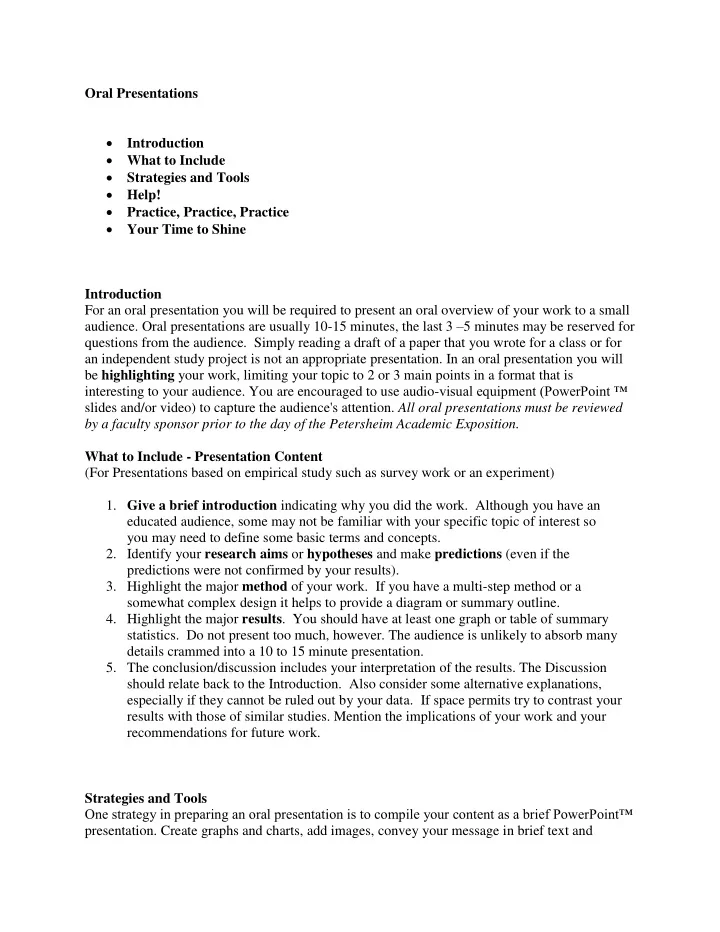

Oral Presentations Introduction What to Include Strategies and Tools Help! Practice, Practice, Practice Your Time to Shine Introduction For an oral presentation you will be required to present an oral overview of your work to a small audience. Oral presentations are usually 10-15 minutes, the last 3 – 5 minutes may be reserved for questions from the audience. Simply reading a draft of a paper that you wrote for a class or for an independent study project is not an appropriate presentation. In an oral presentation you will be highlighting your work, limiting your topic to 2 or 3 main points in a format that is interesting to your audience. You are encouraged to use audio- visual equipment (PowerPoint ™ slides and/or video) to capture the audience's attention. All oral presentations must be reviewed by a faculty sponsor prior to the day of the Petersheim Academic Exposition. What to Include - Presentation Content (For Presentations based on empirical study such as survey work or an experiment) 1. Give a brief introduction indicating why you did the work. Although you have an educated audience, some may not be familiar with your specific topic of interest so you may need to define some basic terms and concepts. 2. Identify your research aims or hypotheses and make predictions (even if the predictions were not confirmed by your results). 3. Highlight the major method of your work. If you have a multi-step method or a somewhat complex design it helps to provide a diagram or summary outline. 4. Highlight the major results . You should have at least one graph or table of summary statistics. Do not present too much, however. The audience is unlikely to absorb many details crammed into a 10 to 15 minute presentation. 5. The conclusion/discussion includes your interpretation of the results. The Discussion should relate back to the Introduction. Also consider some alternative explanations, especially if they cannot be ruled out by your data. If space permits try to contrast your results with those of similar studies. Mention the implications of your work and your recommendations for future work. Strategies and Tools One strategy in preparing an oral presentation is to compile your content as a brief PowerPoint™ presentation. Create graphs and charts, add images, convey your message in brief text and
organize the slides in a logically sequenced order. You can then go back and edit, add, or remove slides to complete your presentation. Consider using the notes section of a slide to include your major speaking points. You do not want to simply read the text from your slides, so minimize the text in the slides that the audience will see and rely on your notes to remind you what to say for that slide. Print out the slides with notes so that you can have them with you during your presentation. There are always new online tools you can use for presentations. If you are going this route, best to use a mature company so your presentation will not disappear. Available since 2009, Prezi (http://prezi.com/) is a cloud based, presentation and storytelling tool that has been. It is distinguished by its zooming user interface and virtual canvas. HELP! Ask for It! Meet with your faculty sponsor to discuss your presentation. All oral presentations must be reviewed by a faculty sponsor prior to the day of the Exposition. Do not hesitate to approach other faculty and students for comments on early drafts of your presentation. Attend a Presentation Workshop! The Teaching, Learning and Technology Center offers free Presentation Design workshops as part of their student technology program, SwitchedOn . These sessions cover working with images and text following effective graphic design principles. Come with an open mind and your presentations will never be the same. Attend for special gifts! Designing an Effective Presentation Wednesday, April 3, 2013 from 4:00 p.m. – 5:30 p.m. Register here » Wednesday, April 3, 2013 from 6:00 pm – 7:30 p.m. Register here » Thursday, April 4, 2013 from 4:00 p.m. – 5:30 p.m. Register here » Thursday, April 4, 2013 from 6:00 pm – 7:30 p.m. Register here » Open Lab for Creating Presentations Monday, April 8, 2013 from 4:00 p.m. – 5:30 p.m. Register here » Monday, April 8, 2013 from 6:00 pm – 7:30 p.m. Register here » Note: You will have better success in the open lab if you have attended one of the Designing an Effective Presentation workshops and have started on your presentation. All workshops are held in the Computer Training Classroom, Bottom Floor of Walsh Library.
Practice, Practice, Practice! Practice your presentation more than once. This will allow you to time it (trim it down in necessary) and increase your familiarity with the main points that you need to make. Nervousness is a common experience for presenters. Try to remain enthusiastic and keep in mind that several members of the audience are also nervous presenters. The audience knows how you feel and is empathetic. Practice helps! Practice may not eliminate nervousness but you will be better prepared and more confident. Your Time to Shine! If your application for an oral presentation is accepted, the day and time will be determined by the committee and posted on this Web Site. You should be prepared to present on any of the days of the Exposition.
Recommend
More recommend